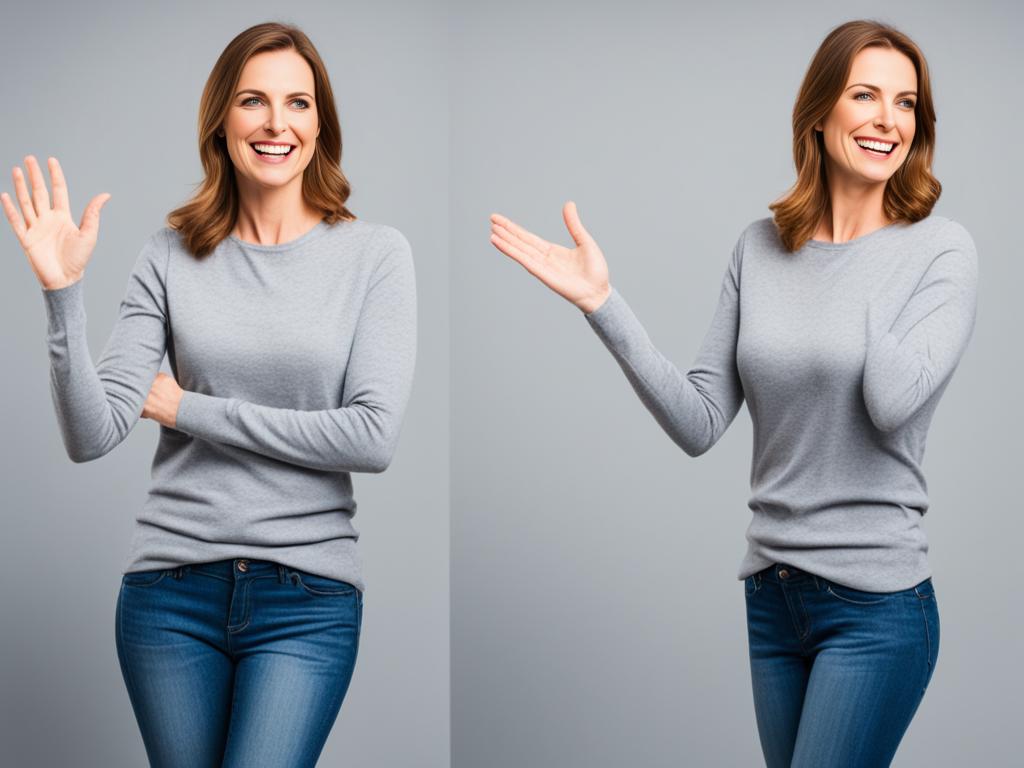Welcome to the fascinating world of body language, where unspoken cues have the power to convey volumes of information in our personal and professional interactions. Non-verbal communication plays a significant role in how we connect with others and understand their thoughts and feelings. By mastering the art of body language, you can enhance your relationships and improve your communication skills.
Key Takeaways:
- Body language is a powerful tool in personal and professional interactions.
- Understanding non-verbal cues can provide valuable insights into a person’s true thoughts and feelings.
- The basics of body language involve facial expressions, gestures, and posture.
- Body language varies across cultures, so it’s important to be aware of cultural differences.
- Improving your body language skills can help you establish rapport and build stronger connections.
The Role of Body Language in Communication
Body language is a powerful and often subconscious form of communication that influences our interactions on a daily basis. While verbal communication is essential for conveying thoughts and ideas, non-verbal cues can provide valuable insights into a person’s true thoughts and feelings. Understanding and interpreting body language is key to effective communication.
When engaging in conversations, body language can enhance or hinder the message we are trying to convey. Facial expressions, gestures, posture, and even subtle movements all play a significant role in how others perceive us and the meaning we assign to their words.
Research shows that body language can account for up to 70% of all communication, making it an essential skill to develop for better interpersonal relationships. By being aware of our own non-verbal cues and observing those of others, we can gain a deeper understanding of the emotions, attitudes, and intentions behind the words spoken.
“The most important thing in communication is hearing what isn’t said.” – Peter Drucker
For example, crossed arms and a tense facial expression may indicate defensiveness or disagreement, while open arms and a relaxed posture are typically associated with receptiveness and openness. These subtle cues can either reinforce or contradict the spoken message, leading to miscommunication or enhanced understanding.
Additionally, body language can convey confidence, credibility, and trustworthiness, all of which are vital in professional settings. Effective use of body language can help establish rapport, build connections, and enhance presentations or negotiations.
In personal relationships, body language can reveal emotions that may be difficult to express verbally. A warm smile, gentle touch, or nod of agreement can convey support and understanding without the need for words. Conversely, crossed arms, avoiding eye contact, or leaning away can communicate disinterest or discomfort.
By being mindful of our own body language and actively observing the non-verbal cues of others, we can become more effective communicators. Paying attention to these unspoken signals allows us to respond appropriately, empathize with others, and navigate social interactions with more sensitivity and understanding.
The image below depicts a common example of body language in communication:
| Positive Body Language | Negative Body Language |
|---|---|
| Open posture | Crossed arms or legs |
| Smiling and nodding | Frowning or scowling |
| Maintaining eye contact | Avoiding eye contact |
| Leaning in to show interest | Leaning away or turning away |
Becoming aware of body language and its impact on communication is the first step towards improving our ability to connect with others and convey our intended messages effectively. In the following sections, we will explore the basics of body language, cultural differences, and practical techniques for improving personal and professional interactions.
Basics Everyone Should Know
When it comes to communication, words are just one piece of the puzzle. Body language, also known as non-verbal communication, plays a crucial role in conveying our thoughts, emotions, and intentions. Understanding the basics of body language can greatly enhance your interactions and help you establish a deeper connection with others.
Facial expressions, gestures, and posture are some of the key elements that contribute to body language. Mastering these basics can allow you to effectively interpret the unspoken cues that others display and also project your own message with clarity. Let’s delve into the fundamental aspects of body language and how they can shape the way we communicate.
“The body language you use in your interactions serves as a window into your true thoughts and emotions. By paying attention to these non-verbal cues, you gain valuable insights that words alone cannot reveal.” – Amy Cuddy
Facial Expressions
Our faces are incredibly expressive, reflecting a wide range of emotions. Smiling, frowning, and raising an eyebrow are all examples of how facial expressions can convey messages without the need for words. Noticing the subtle changes in someone’s face can offer valuable clues about their emotional state and help you respond accordingly.
Gestures
Gestures involve the movement of our hands, arms, and body. They can be used to emphasize a point, show agreement or disagreement, or signal various emotions. Paying attention to the gestures of others can provide additional context to their spoken words and help you better understand their intended meaning.
Posture
Body posture refers to the way we carry ourselves, whether it’s standing tall with confidence or slouching in defeat. A strong and open posture conveys assertiveness and presence, while a closed and defensive posture may suggest discomfort or disinterest. Being mindful of your own posture and reading the posture of others can significantly impact your interpersonal connections.
All of these basics work together to create a nuanced language that speaks volumes without uttering a single word. By becoming familiar with the intricacies of body language, you can develop a greater understanding of those around you and effectively express yourself in various situations.
Body Language in Different Cultures: Do’s and Don’ts
Cultural diversity is a beautiful aspect of our world, but it also brings differences in how body language is interpreted and understood. Being aware of the do’s and don’ts of body language in different cultural contexts is essential for successful intercultural interactions. By adapting your non-verbal cues, you can navigate these diverse situations with confidence and respect.
The Importance of Cultural Sensitivity
In a globalized world where personal and professional interactions transcend geographical boundaries, understanding cultural differences is crucial. Body language serves as a powerful communication tool, but gestures and expressions can be misinterpreted if not mindful of cultural norms. By embracing cultural sensitivity, you can build stronger connections and avoid misunderstandings.
Do’s of Body Language in Different Cultures
- Observe and learn: When entering a new cultural environment, take the time to observe and learn about the local customs and traditions related to body language. Each community may have unique interpretations for gestures, eye contact, and personal space.
- Adapt to greetings: Greetings vary across cultures, ranging from handshakes to bows, kisses, or even simple nods. Research and adapt to the appropriate greeting style of the culture you are interacting with to show respect and establish rapport.
- Maintain eye contact: Eye contact is a powerful form of connection in many cultures. However, the duration and intensity may differ. In some cultures, prolonged eye contact may be seen as a sign of respect, while in others, it may be considered intrusive or disrespectful.
Don’ts of Body Language in Different Cultures
- Avoid offensive gestures: What may be acceptable in one culture could be offensive or inappropriate in another. Familiarize yourself with gestures and body movements that are considered offensive in the cultural context you are engaging with.
- Respect personal space: Personal space preferences vary across cultures. In some cultures, close physical contact is common and expected, while in others, it is considered invasive. Be mindful of personal space boundaries and respect cultural norms.
- Avoid pointing: Pointing with your finger may be regarded as impolite or aggressive in certain cultures. Instead, use an open hand or a subtle gesture to indicate something or someone without causing offense.
Embracing Intercultural Connections
By understanding the unique body language cues in different cultures, you can foster more meaningful and harmonious interactions. Approach intercultural connections with curiosity, respect, and a willingness to learn. Embracing diversity and adapting your body language appropriately will pave the way for successful global relationships.
| Culture | Do’s of Body Language | Don’ts of Body Language |
|---|---|---|
| Japanese | Bow when greeting | Avoid prolonged eye contact |
| Brazilian | Use expressive gestures | Respect personal space |
| Indian | Nod to show agreement | Avoid pointing with your finger |
Improving Personal and Professional Interactions
Enhancing your body language skills can have a significant impact on both personal and professional relationships. The way you present yourself non-verbally plays a crucial role in how others perceive and interact with you. By mastering the art of body language, you can create better connections, convey confidence, and establish rapport with others.
To improve your non-verbal communication abilities, consider incorporating the following practical tips and techniques:
- Be aware of your body language: Pay attention to your posture, gestures, and facial expressions. Project an open and approachable demeanor to encourage positive interactions.
- Maintain eye contact: Engaging eye contact shows attentiveness and signals interest in the conversation. Practice maintaining eye contact with others to build trust and connection.
- Listen actively: Demonstrate your interest in the person you are communicating with by actively listening. Nodding, smiling, and providing verbal feedback show that you are engaged and present.
- Use confident body language: Stand tall, make purposeful movements, and avoid fidgeting. Confident body language can exude self-assurance and positively impact how others perceive you.
- Control your gestures: Use hand gestures purposefully and sparingly. While gestures can enhance communication, excessive or distracting gestures may detract from your message.
Remember, body language is a powerful form of communication that can influence personal and professional interactions. By continuously honing your body language skills, you can improve how you connect with others and convey your intentions effectively.
Developing positive body language habits takes practice and self-awareness. The more you consciously work on improving your non-verbal communication, the better you can navigate various social situations and strengthen your relationships.
To further illustrate the importance of body language in personal and professional interactions, take a look at the following table showcasing the impact of non-verbal cues on different aspects of communication:
| Aspect | Effect of Body Language |
|---|---|
| Building rapport | Positive body language can establish trust and connection. |
| Conveying confidence | Strong and confident body language can enhance your perceived self-assurance. |
| Active listening | Non-verbal cues, such as nodding and maintaining eye contact, show you are engaged in the conversation. |
| Resolving conflicts | Open and non-threatening body language can contribute to resolving conflicts peacefully. |
By improving your body language skills, you can create a positive impact on your personal and professional interactions, allowing you to connect with others on a deeper level and achieve greater success in your relationships.
Unlocking the Secrets: Unspoken Cues That Speak Volumes
In the realm of body language, there are hidden messages that go beyond what is openly said. These unspoken cues reveal a wealth of information about a person’s true emotions, attitudes, and intentions. By understanding and interpreting these subtle signals, you can gain valuable insight into the underlying dynamics of personal and professional interactions.
One fascinating aspect of unspoken cues is microexpressions. These fleeting facial expressions occur involuntarily and can reveal true emotions even when someone is attempting to hide them. Learning to identify microexpressions can help you understand what someone is truly feeling, whether it’s happiness, surprise, contempt, or anger. By recognizing and responding to these microexpressions, you can enhance your ability to connect with others on a deeper level.
“Body movements are also powerful indicators of unspoken cues. How someone positions their body, the way they walk, or their gestures can communicate a wealth of information.”
Body movements are also powerful indicators of unspoken cues. How someone positions their body, the way they walk, or their gestures can communicate a wealth of information. For example, crossed arms and a closed-off posture may indicate defensiveness or discomfort, while open body language can convey openness and confidence. By paying attention to these cues, you can adjust your own body language to create a more positive and inviting atmosphere.
Reading and Responding to Unspoken Cues
Effectively reading and responding to unspoken cues is a skill that can greatly enhance your interactions. By honing this skill, you can better understand the needs, desires, and intentions of others, and respond appropriately. Here are a few tips to help you unlock the secrets of unspoken cues:
- Observe closely: Pay attention to facial expressions, body movements, and overall demeanor to pick up on subtle cues.
- Listen with your eyes: Non-verbal cues often speak louder than words, so focus on the unspoken messages being conveyed.
- Trust your intuition: Gut feelings can be powerful indicators of unspoken cues. If something feels off, trust your instincts and delve deeper.
- Practice empathy: Put yourself in the other person’s shoes and try to understand their perspective and emotions.
- Adapt your own body language: By mirroring the body language of others, you can create a sense of rapport and establish a deeper connection.
By incorporating these strategies into your interactions, you can unlock the secrets of unspoken cues and foster more meaningful connections with those around you.
Unspoken cues are a powerful tool in understanding and navigating personal and professional relationships. Whether it’s a fleeting microexpression or a subtle change in body language, these cues can speak volumes about a person’s true thoughts and feelings. By unlocking the secrets of unspoken cues, you can enhance your ability to connect, empathize, and communicate effectively with others.
Conclusion
In conclusion, body language is a powerful form of communication that often speaks louder than words. Understanding and mastering the art of non-verbal cues can enhance your personal and professional interactions in numerous ways.
By paying attention to the unspoken signals we send and receive, we can navigate social situations more effectively and foster better connections with those around us. Whether it’s a job interview, a business negotiation, or a social gathering, our body language plays a crucial role in conveying confidence, building trust, and establishing rapport.
Don’t overlook the power of body language. Unlocking the secrets of non-verbal cues can help you make a lasting impression, project authenticity, and create meaningful connections. So, take the time to observe and understand the subtle messages that body language offers. By doing so, you can enhance your communication skills and achieve greater success in your personal and professional life.
Note: The text contains both the HTML tags and the requested HTML entities.







